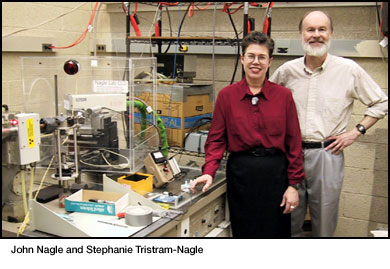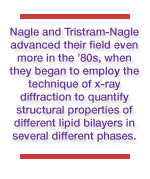|
|
||||
|
|
 Husband-Wife Team of Scientists Garner Avanti Award For their significant field-altering contributions to biophysics, Mellon College of Science husband-wife team of John Nagle and Stephanie Tristram-Nagle have received the Avanti Award in Lipids from the Biophysical Society. Their work focuses on indispensable lipid bilayers, which form the fundamental core of the biological membranes that encapsulate a cell's contents. Lipid bilayers prevent cellular intruders, but also easily accommodate proteins that allow critical molecules —like neurotransmitters, ions and hormones—to bind to or enter cells. The chemical characteristics of lipids naturally drive them to form bilayers. "Lipid molecules are surface active and have a schizophrenic reaction to water—one end of the molecule loves it and the other hates it," said John Nagle, professor of physics and biological sciences. "Therefore, these molecules self-assemble into sheets that have the nice property for biology in that they compartmentalize space. They are what divide us into pieces at the cellular level."
Nagle and Tristram-Nagle, a senior research biologist, advanced their field even more in the '80s, when they began to employ the technique of x-ray diffraction to quantify structural properties of different lipid bilayers in several different phases. "The challenge for doing structural studies on the biologically relevant phase of lipid bilayers is that they don't have the usual kind of structure," notes Tristram-Nagle. For most of the 1990s, they and their students struggled to overcome the effects of liquid crystal fluctuations to obtain reliable information about the structure of liquid crystals. "By addressing the fluctuations between bilayers, you can tease out the structure," says Tristram-Nagle. By characterizing these fluctuations using the methods of statistical mechanics, the team has pioneered the development of liquid crystallography. While not high profile outside their field, the work of Nagle and Tristram-Nagle enables investigators in a variety of fields to conduct studies that address more specific aspects of lipid bilayers as encountered in biological membranes or synthetic materials. "We're really providing a cornerstone with our data and numbers that others use," remarks Nagle. "Our work combines volume and x-ray data to give the area of a lipid bilayer, an important quantity that researchers need to know when running a simulation," Tristram-Nagle adds. Future studies in the laboratory of Nagle and Tristram-Nagle will focus on putting peptides such as the HIV fusion peptide into lipid bilayers to better understand how the HIV virus attacks cells. Their research is being funded by a $1 million, four-year grant from the National Institutes of Health. Avanti Polar Lipids, Inc., bestows the Avanti Award biennially, alternating between the Biophysical Society and the American Society for Biochemistry and Molecular Biology. Winners, who receive a cash prize, are outstanding investigators known for their seminal studies in lipid metabolism, lipid enzymology or lipids in membranes.
The Biophysical Society is a professional organization with nearly 7,000 members in the United States and more than 45 countries. The society encourages development and dissemination of knowledge in biophysics through its journal, Biophysical Journal, its annual meeting, smaller discussions workshops, subgroups, newsletter, and outreach programs conducted by society committees.
Lauren Ward
|
||
|
Carnegie Mellon Home |
||||
 Like many materials, lipid bilayers form different phases that change with temperature, but only the "fluid" phase is biologically relevant. In the 1970s, John Nagle accomplished the "holy grail" of his original theoretical field of statistical mechanics by developing a model that he solved without mathematical approximation. This work led him to experimental research that provided evidence supporting the physical ingredients of the model.
Like many materials, lipid bilayers form different phases that change with temperature, but only the "fluid" phase is biologically relevant. In the 1970s, John Nagle accomplished the "holy grail" of his original theoretical field of statistical mechanics by developing a model that he solved without mathematical approximation. This work led him to experimental research that provided evidence supporting the physical ingredients of the model.